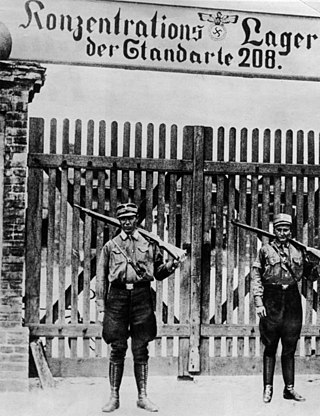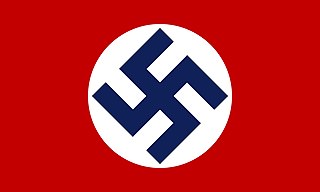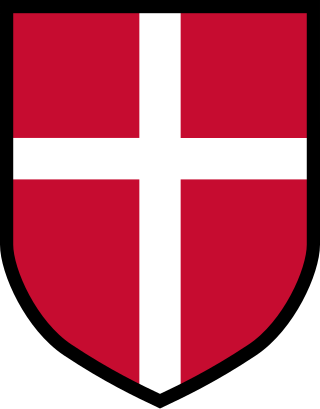The Sturmabteilung was the original paramilitary wing of the Nazi Party. It played a significant role in Adolf Hitler's rise to power in the 1920s and 1930s. Its primary purposes were providing protection for Nazi rallies and assemblies, disrupting the meetings of opposing parties, fighting against the paramilitary units of the opposing parties, especially the Roter Frontkämpferbund of the Communist Party of Germany (KPD) and the Reichsbanner Schwarz-Rot-Gold of the Social Democratic Party of Germany (SPD), and intimidating Romani, trade unionists, and especially Jews.
The following table show comparative officer ranks of World War II, with the ranks of Allied powers, the major Axis powers and various other countries and co-belligerents during World War II.

The uniforms and insignia of the Schutzstaffel (SS) served to distinguish its Nazi paramilitary ranks between 1925 and 1945 from the ranks of the Wehrmacht, the German state, and the Nazi Party.

Frits Clausen was leader of the National Socialist Workers' Party of Denmark (DNSAP) prior to and during World War II.

The uniforms and insignia of the Sturmabteilung (SA) were Nazi Party paramilitary ranks and uniforms used by SA stormtroopers from 1921 until the fall of Nazi Germany in 1945. The titles and phrases used by the SA were the basis for paramilitary titles used by several other Nazi paramilitary groups, among them the Schutzstaffel (SS). Early SS ranks were identical to the SA, since the SS was originally considered a sub-organization of the Sturmabteilung.

Ranks and insignia of the Nazi Party were paramilitary titles used by the National Socialist German Workers' Party (NSDAP) between approximately 1928 and the fall of Nazi Germany in 1945. Such ranks were held within the political leadership corps of the Nazi Party, charged with the overseeing of the regular Nazi Party members.

The War Order of the German Cross, normally abbreviated to the German Cross or Deutsches Kreuz, was instituted by Adolf Hitler on 28 September 1941. It was awarded in two divisions: in gold for repeated acts of bravery or military leadership; and in silver for distinguished non-combat war service. The German Cross in Gold ranked higher than the Iron Cross First Class but below the Knight's Cross of the Iron Cross, while the German Cross in Silver ranked higher than the War Merit Cross First Class with Swords but below the Knight's Cross of the War Merit Cross with Swords.

The National Socialist Motor Corps was a paramilitary organization of the Nazi Party (NSDAP) that officially existed from May 1931 to 1945. The group was a successor organisation to the older National Socialist Automobile Corps, which had existed since April 1930.

The National Socialist Workers' Party of Denmark was the largest Nazi Party in Denmark before and during the Second World War.

Political decorations of the Nazi Party were medals and awards issued by the National Socialist German Workers Party (NSDAP) between 1920 and 1945. Political awards were authorized for wear on any paramilitary uniform of Nazi Germany, as well as civilian attire, but were generally discouraged on Wehrmacht military uniforms. The Waffen-SS freely wore both political awards and military decorations on their uniforms.

The National Socialist Dutch Workers Party was a minor Dutch Nazi party founded in 1931 and led by Ernst Herman van Rappard. Seeking to copy the fascism of others, notably Adolf Hitler, the group failed to achieve success and was accused by rivals such as the National Socialist Movement in the Netherlands (NSB) and the General Dutch Fascist League of being too moderate for a fascist movement.

Free Corps Denmark was a unit of the Waffen-SS during World War II consisting of collaborationist volunteers from Denmark. It was established following an initiative by the National Socialist Workers' Party of Denmark (DNSAP) in the immediate aftermath of the German invasion of the Soviet Union in June 1941 and subsequently endorsed by Denmark's government which authorised officers of the Royal Danish Army to enlist in the unit. It participated in fighting on the Eastern Front and was disbanded in 1943. During the course of the war, approximately 6,000 Danes joined the corps, including 77 officers of the Royal Danish Army.

Cay Lembcke was a co-founder of the Danish Boy Scouts Organization in 1910 and the National Socialist Workers' Party of Denmark in 1930. He was captain of the Danish Guard Hussars until his resignation in 1923, following public disagreement with the Danish government over budget cuts in the Danish defence.
Max Johannes Arildskov was a Danish National Socialist political activist and collaborator prior to and during World War II.
The comparative ranks of Nazi Germany contrasts the ranks of the Wehrmacht to a number of national-socialist organisations in Nazi Germany from 1933 to 1945 in a synoptic table. Nazi organisations used a hierarchical structure, according to the so-called Führerprinzip, and were oriented in line with the rank order system of the Wehrmacht.
The Ranks of the Independent State of Croatia Armed Forces are the ranks used by the Independent State of Croatia, it had similar insignia to those of the Armed Forces of Nazi Germany.
Bovrup-kartoteket is a partial transcript of the member file of the National Socialist Workers' Party of Denmark created in 1945 by Danish resistance members and published as a book in 1946. The transcript is named after Bovrup, the hometown of DNSAP's leader Frits Clausen who created the actual DNSAP member file. The transcript is incomplete with 22,795 entries, while the actual DNSAP member file had 50,000 entries.
The Military ranks of the Kingdom of Romania were the military insignia used by the Kingdom of Romania. Following the abolition of the monarchy, the ranks were replaced with those of the Socialist Republic of Romania.
The Military ranks of Slovakia (1939-1945) were the military insignia used by the Slovak Republic's military and the Hlinka Guard. The Slovak Republic was a landlocked country, and therefore did not possess a navy.
The Military ranks of the Kingdom of Bulgaria were the military insignia used by the Kingdom of Bulgaria. Following the abolition of the monarchy, the ranks were also changed.




























